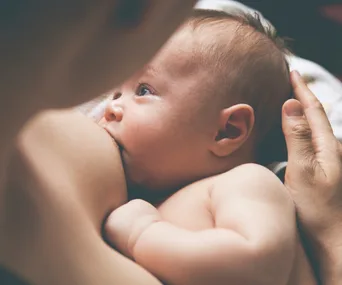UK mum Remi Clog can barely conceal her joy and pride over her adorable baby boy, Rudi, with almost every picture she uploads to Instagram being a family fest of loved-up happy snaps.
^ See, we told you so.
But it was one picture in particular that has caught the attention of mums across the world – a picture that is less about the joy of loving and nurturing such a beautiful baby boy.
It is a picture that provides raw, honest insight into how painful breastfeeding a child can actually be, and what can happen if the pain then takes a worrying turn…
“When I got home [from hospital], problems started to arise – my nipple literally cracked in half,” Remi wrote on Instagram, talking about what it was like to breastfeed when she felt it didn’t come naturally to her.
“I have never felt such pain, I dreaded every feed, but persisted with tears in my eyes until I was healed. (Nobody taught me that breastfeeding could be painful, nobody taught me what a good latch looked like.)”
She then went on to describe that when she was with her son in public, she would either go to the bathroom or pump at home and feed him with a bottle.
“I felt embarrassed and as though I would make others uncomfortable. This resulted in clogged ducts and engorgement. (I feed freely in public now, and have done for a long time.)”
But what came next was not just “excruciating” for Remi, but terrifying.
“I remember waking up at 3am shivering, putting on my dressing gown and extra blankets and trying to feed my son. The pain. It was excruciating,” she continued.
“I was shaking and sweating but freezing to my bones.”
“At 5 am I woke up my boyfriend and told him I thought I needed to go to the hospital. We got my stepdad, a doctor, he took my temperature and said it was slightly high, but to take a paracetamol and try and sleep.”
“7am comes, I’ve had no sleep, and now I’m vomiting, he takes my temperature again: 40˚c. I had developed sepsis overnight.”
“This was because I was not able to recognise the more subtle signs of mastitis (as I had seen no redness that day) I was rushed to resus, given morphine, anti-sickness [medication] and the strongest antibiotics they could give, and separated from my baby for two nights.”
“I was heartbroken.”
The reason Remi has been so candid with her experience with mastitis is because she believes that more women need to be educated on what breastfeeding is all about before the baby is born.
“Breastfeeding is HARD, it needs to be taught and it needs to be learned. Just like walking, talking, reading and writing – it may be natural, but it does not always come naturally. And this is what I should have known but didn’t,” she says.
“If new mothers knew just how difficult it can be at first, more would take themselves to prenatal breastfeeding classes, buy books, join forums, and ask more questions – but we don’t. We just assume that it will feel as natural as breathing. Because no-one ever told us.”
So, what is mastitis?
According to the Australian Breastfeeding Association, mastitis is the inflammation of breast tissue caused by a blocked milk duct. This happens when breast milk is being produced faster than it is being removed.
One of the main causes of mastitis occurs when a baby isn’t taking enough milk from their mother’s breast, or they’re not latching properly, trapping the milk within the breast’s milk ducts.
What are the symptoms?
The breast may be red, and feel sore and tender. Someone with mastitis may also experience flu-like symptoms, including feeling hot and cold, with aching joints.
If you would like to know more about mastitis, call the Australian Breastfeeding Association on 1800 686 268 or visit their website. You can also book an appointment to discuss this further with your GP.

